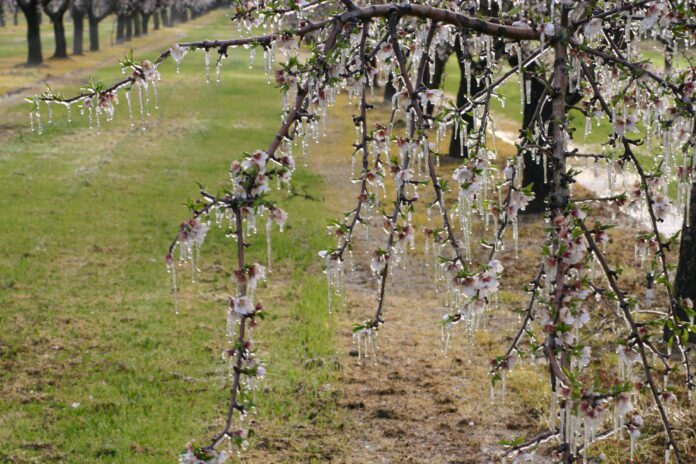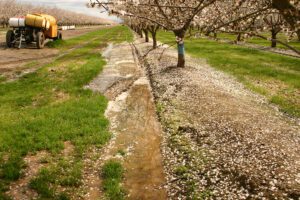
Heading into 2024, there are several things that need to be done before bloom for the best shot at a good season.
Maximum production starts with winter sanitation, good quality bees and, depending upon the weather, proper fungicide protection. “Basically, good pollination and protecting the flowers are the key for bloom,” said Franz Niederholzer, UCCE farm advisor for Colusa, Sutter and Yuba counties.
Setting a crop and getting pollinization, particularly for the traditional varieties like Nonpareil and the pollinizers, requires cross pollinization, so it’s critical to have good bee activity in the orchard, Niederholzer said.
“Bee activity is not quite so important for the popular self-fertile variety Independence,” Niederholzer said. In recent research, Independence trees set nuts without bee activity, but yields were 20% less compared to yields from trees where bees were active. He’s not aware of similar research information on other self-fertile varieties.
Winter Sanitation
“It can’t be repeated often enough, but orchard sanitation is critical,” Niederholzer said, “especially this year because there were high, high numbers of navel orangeworm (NOW) in many orchards. The kind of numbers I haven’t seen in a long time, I’ve never seen this kind of damage before. The most important thing growers can do is to get the mummies out of the trees by February 1 and destroyed before March 1.”
How soon should growers start orchard sanitation? There is no cut and dry answer.
Research done in the Modesto area a few years ago by Wes Asai, suggests winter sanitation can go slightly into the bud swell. “In the two years of the study, years they were looking at, successful sanitation (mummy removal without harming the crop) was done as late as February 10 to 11,” Niederholzer said. “The University recommends you should be done by February 1, but, if needed, this research shows you can stretch it a bit to clean off the mummies. Some buds will be shaken off in later sanitation, but you only need to have 25% to 30% set to get a good crop. Even if 20% of the buds are removed, it shouldn’t affect yield.”
Asai’s research knocked off some buds, but yield at harvest wasn’t affected. The goal is to get the mummies off before bud swell, but if needed, the practice can be pushed an extra week or so. Because bloom timing differs from year to year, growers will need to make the decision for a late mummy shake based on local conditions.
“The mummies have to be removed,” Niederholzer said, but trying to remove them early before rainfall and fog loosen the mummies might mean having to go in again, which is time-consuming and costly.
A better option might be to try a few rows, then check to see if the mummies are coming off before continuing, Niederholzer said. “If they’re coming off well, great. If they’re not, you’re wasting your time and better off waiting.”
Moisture from fog and rain help to soften up the mummies. “Growers down on the valley floor where the ground is heavier, there are tracks available for the shakers. It isn’t a slam dunk, but it certainly helps with access if their orchard floor is wet,” Niederholzer said.
Certain varieties like Winters have more problems with sticktights, which makes mummy removal more difficult. “Some people have had trouble getting Independence to clear too. Younger orchards, where the nuts are stuck directly on the shoots and scaffolds, not on spurs, can be hard to clear. If you have high boron, that can tend to stick things on, so there are a number of factors that contribute to making it difficult to remove the mummies,” Niederholzer said.
The bottom line: If the mummies aren’t removed, there could be high NOW damage in 2024, Niederholzer said.
Frost Control
Frost control is also important, particularly in cooler climates. “We’ve had two years of brutal weather, at least in the Sacramento Valley, and the frost of 2022 hit some other places as well, but it really hit hard up here,” Niederholzer said, so he reminds growers to have their ducks in a row and be ready with frost protection.
Niederholzer recommends if there’s frost in the forecast, mow the orchard floor down to two inches and have ground wet because wet, dark ground holds more heat than dry soil.
“The moisture needs to only be in the top foot of soil for frost protection. The root zone doesn’t have to be completely soaked for that passive frost protection that comes from just having moist soil soaking up heat all day and then radiating it at night,” Niederholzer said.
Bloom Sprays
Last year was an extremely wet year, making it difficult to make spray applications in some orchards. Having aerial support for spray applications should be considered, too, particularly if there is another wet year.
Depending upon the weather, moisture and temperature, there could be problems with bacterial blast, brown rot, anthracnose and jacket rot (also called green fruit rot), and at the end of full bloom, shot hole can be a problem too.
Brown rot at bloom is a big problem. This disease prefers warm weather as does anthracnose, but other bloom diseases like jacket rot are problematic with cooler weather. If it’s wet, an aerial application is going to be critical.
“Two fungicide spray applications are recommended in wet bloom weather, one at pink bud stage and one at full bloom. If bloom is relatively dry (little to no rain), a single fungicide at 40% to 50% full bloom is recommended,” Niederholzer said.
“There are a number of organisms and pathogens that are a problem at bloom. Talk to your PCA and/or check out the university’s recommendations on efficacy for different materials because all fungicides do not, I emphasize, do not control all the pathogens out there at bloom,” Niederholzer said.
“If at all possible, avoid spraying when bees are active,” Niederholzer said.
It’s important to be in contact with beekeepers to discuss proposed materials and make sure there are no insecticides used. The exception to this is Bacillus thuringiensis (Bt) and a few others recommended by the university when bees are present. These precautions are taken to avoid contaminating the hive, Niederholzer said.
“Good, strong hives will strip the current day’s pollen out of an orchard by midafternoon. If you’re going to use a ground rig, the preferred approach is to spray late afternoon into the evening and through the night depending upon your operation to avoid contaminating the pollen,” Niederholzer said.

Scale
Scale could be problematic in some orchards in 2024 because numerous spray applications were made for navel orangeworm in 2023, especially where pyrethroids were used. This could reduce parasitoid activity and result in higher scale populations.
“It’s not something to put on the level of sanitation, but scale can sneak up on you if you’re not paying attention,” Niederholzer said, and advised taking a dormant spur sample once the leaves start to defoliate.
If scale is building, apply a dormant spray before bloom and selectively spray blocks, depending upon the scale level, late December to the first half of January, Niederholzer advised.

Using just an oil application for low to moderate scale populations is effective and won’t harm beehive health, but for higher levels of scale populations, an insecticide will need to be applied with the oil, Niederholzer said.
“With a big scale problem, it’s much better to tank mix the oil and insecticide,” Niederholzer said, adding the insecticide will impact the bees.
“Scale management is something to keep in the mix, but not to have at the top of your list, and it doesn’t have to be done every year, but it’s something that’s a good idea,” Niederholzer said.
Boron is generally applied in the fall, but if it doesn’t happen, it can be applied at early bloom before the flowers are open. Be sure to make the application late in the day and avoid spraying the bees directly, Niederholzer said.















